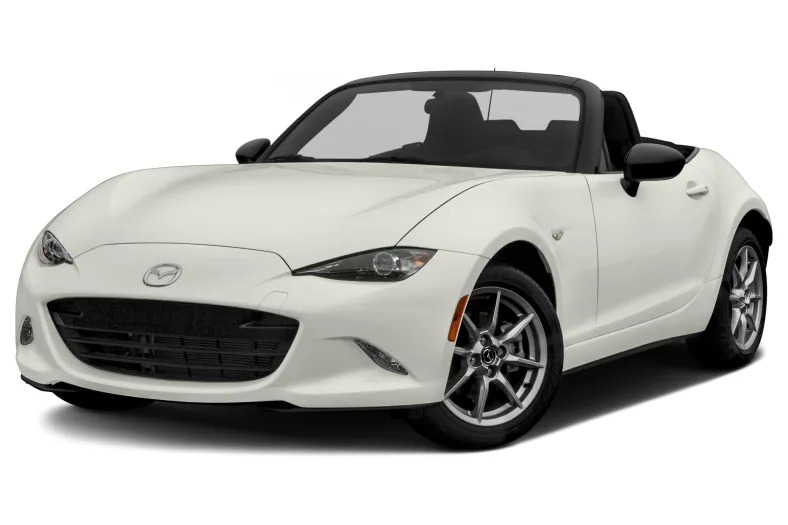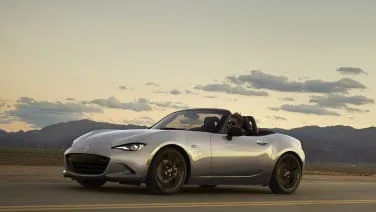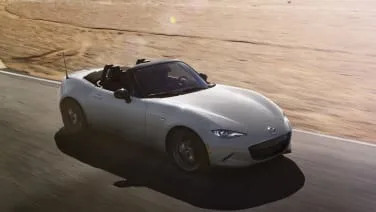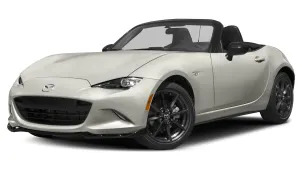Sport 2dr Convertible
2016 Mazda MX-5 Miata
The 2016 Mazda MX-5 Miata is easy to comprehend. It is an enthusiast roadster in its purest form. There's no need for any sort of sales pitch. You don't have to ramp up in order to get people excited about it. Say the words "new Miata" to anyone who cares about cars, and you've immediately got their attention. And now that I have yours, I'll to cut right to the chase. It's brilliant. That's a fact I've known for a while. I drove the Japanese-spec ND Miata in Spain earlier this year, with the 130-horsepower, 1.5-liter engine that we aren't getting in the United States. The new Miata is a modern day reincarnation of the original NA that stole our hearts in 1989. It's smaller and lighter than the outgoing NC, yet boasts more interior room. It's comfortable. It looks great. And it drives like a Miata should. In other words, it's perfect. So what about this US-spec car, then? It's got more power – 155 horsepower and 148 pound-feet of torque from Mazda's 2.0-liter Skyactiv four-cylinder engine. But it's also heavier. Our car weighs 2,332 pounds, compared to the roughly 2,200 pounds of the 1.5-liter car. Yes, the ND Miata loses 12 hp compared to the outgoing NC, but it's up 8 lb-ft of torque. Plus, according to Mazda, because of the improved powerband, anytime you're under 5,700 rpm the new Skyactiv engine is stronger than the old MZR mill. It's more efficient, too. With the manual transmission, the Miata is estimated to achieve 27 miles per gallon in the city and 34 mpg highway. That a jump of six mpg in both categories compared to the old six-speed. Consider this: The Japanese-spec car uses a 130-hp engine, which I found to be perfectly adequate. The increase in power for the US-spec car mostly just balances out the extra weight, but it also improves performance on the highway. Hit the throttle in sixth gear with the 1.5 and nothing happens. Do the same with the 2.0, and there's movement. Low-end power is far more important in the US than it is in other markets, and that's why our car has the larger engine. "North America is why the two-liter car exists," engineer Dave Coleman told me. Plus, 155 hp power means you eke out the Miata's dynamics at legal speeds. 45 miles per hour in an MX-5 is a far more exhilarating experience than that same speed in any supercar. So yeah, it's not powerful. But to paraphrase Jay-Z, the MX-5 is a super car, not a supercar. Having driven both versions of the Miata, I can say that the added weight makes little to no difference in overall performance. The final curb weight number isn't the main focal point. Instead, concentrate on how the MX-5 throws its weight around. It's perfectly balanced – 50/50, front to rear. Moreover, the car was designed around the driver. No, really. That's not just marketing speak. Engineers started with the driving position …
Full Review
The 2016 Mazda MX-5 Miata is easy to comprehend. It is an enthusiast roadster in its purest form. There's no need for any sort of sales pitch. You don't have to ramp up in order to get people excited about it. Say the words "new Miata" to anyone who cares about cars, and you've immediately got their attention. And now that I have yours, I'll to cut right to the chase. It's brilliant. That's a fact I've known for a while. I drove the Japanese-spec ND Miata in Spain earlier this year, with the 130-horsepower, 1.5-liter engine that we aren't getting in the United States. The new Miata is a modern day reincarnation of the original NA that stole our hearts in 1989. It's smaller and lighter than the outgoing NC, yet boasts more interior room. It's comfortable. It looks great. And it drives like a Miata should. In other words, it's perfect. So what about this US-spec car, then? It's got more power – 155 horsepower and 148 pound-feet of torque from Mazda's 2.0-liter Skyactiv four-cylinder engine. But it's also heavier. Our car weighs 2,332 pounds, compared to the roughly 2,200 pounds of the 1.5-liter car. Yes, the ND Miata loses 12 hp compared to the outgoing NC, but it's up 8 lb-ft of torque. Plus, according to Mazda, because of the improved powerband, anytime you're under 5,700 rpm the new Skyactiv engine is stronger than the old MZR mill. It's more efficient, too. With the manual transmission, the Miata is estimated to achieve 27 miles per gallon in the city and 34 mpg highway. That a jump of six mpg in both categories compared to the old six-speed. Consider this: The Japanese-spec car uses a 130-hp engine, which I found to be perfectly adequate. The increase in power for the US-spec car mostly just balances out the extra weight, but it also improves performance on the highway. Hit the throttle in sixth gear with the 1.5 and nothing happens. Do the same with the 2.0, and there's movement. Low-end power is far more important in the US than it is in other markets, and that's why our car has the larger engine. "North America is why the two-liter car exists," engineer Dave Coleman told me. Plus, 155 hp power means you eke out the Miata's dynamics at legal speeds. 45 miles per hour in an MX-5 is a far more exhilarating experience than that same speed in any supercar. So yeah, it's not powerful. But to paraphrase Jay-Z, the MX-5 is a super car, not a supercar. Having driven both versions of the Miata, I can say that the added weight makes little to no difference in overall performance. The final curb weight number isn't the main focal point. Instead, concentrate on how the MX-5 throws its weight around. It's perfectly balanced – 50/50, front to rear. Moreover, the car was designed around the driver. No, really. That's not just marketing speak. Engineers started with the driving position …
Hide Full Review
Hide Full Review
Retail Price
$24,915
MSRP / Window Sticker Price
| Engine | 2.0L I-4 |
| MPG | 27 City / 34 Hwy |
| Seating | 2 Passengers |
| Transmission | 6-spd man |
| Power | 155 @ 6000 rpm |
| Drivetrain | rear-wheel |
Smart Buy Program is powered by 







